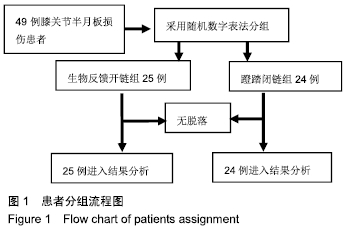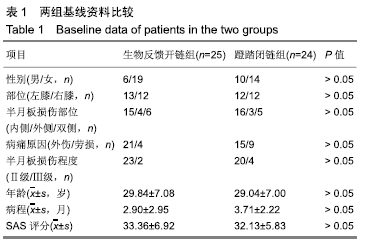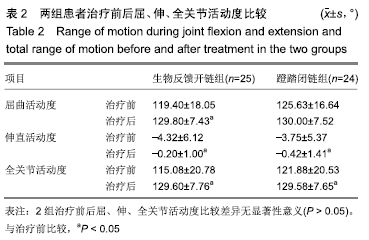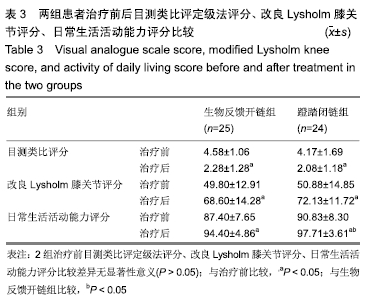[1] 梁炳寅,王惠芳,王予彬.膝前交叉韧带重建术后康复治疗中开链与闭链运动的应用[J].中华物理医学与康复杂志, 2010,32(6):467-469.
[2] 张静,刘虎,朱超华.前十字韧带重建术后开链与闭链康复运动的选择[J].中华骨科杂志,2012,32(2):128-131.
[3] PERRIMAN A, LEAHY E, SEMCIW AI.The Effect of Open-Versus Closed-Kinetic-Chain Exercises on Anterior Tibial Laxity, Strength, and Function Following Anterior Cruciate Ligament Reconstruction: A Systematic Review and Meta-analysis.J Orthop Sports Phys Ther. 2018;48(7):552-566.
[4] 缪萍,王楚怀,潘翠环,等.闭链与开链运动对髌股疼痛综合征股四头肌作用的表面肌电图研究[J].中国康复医学杂志, 2015,30(12):1238-1242.
[5] STENSDOTTER AK, HODGES P, OHBERG F, et al. Quadriceps EMG in open and closed kinetic chain tasks in women with patellofemoral pain.J Mot Behav. 2007;39(3):194-202.
[6] BAKHTIARY AH, FATEMI E.Open versus closed kinetic chain exercises for patellar chondromalacia.Br J Sports Med. 2008;42(2): 99-102.
[7] MATHESON GO.Open versus closed kinetic chain exercises for patellar chondromalacia in young women.Clin J Sport Med. 2009; 19(1):76-77.
[8] ÖZDINÇLER AR, YELDAN,KINALI P.The effects of closed kinetic chain exercise on pain and functional performance of patients with knee osteoarthritis.The Pain Clinic. 2005;17(1):107-115.
[9] LIN DH, LIN YF, CHAI HM, et al.Comparison of proprioceptive functions between computerized proprioception facilitation exercise and closed kinetic chain exercise in patients with knee osteoarthritis. Clin Rheumatol.2007;26(4):520-528.
[10] 国家中医药管理局.中医病证诊断疗效标准[M].南京:南京大学出版社, 1994:196.
[11] 王芗斌,谢雪榕,侯美金,等.电针对膝关节骨性关节炎患者登梯活动时下肢动力学影响的临床研究[J].中国针灸, 2017,37(10):1027-1034.
[12] 刘辉,刘波,张鑫,等.关节粘连传统松解术联合运动疗法治疗下肢骨折术后膝关节功能障碍[J].中医正骨,2013,25(9):47-48.
[13] 陆廷仁.骨科康复学[M].北京:人民卫生出版社,2007:304-305.
[14] ORAVITAN M, AVRAM C.The Effectiveness of Electromyographic Biofeedback as Part of a Meniscal Repair Rehabilitation Programme.J Sports Sci Med.2013;12(3):526-532.
[15] GREGORY HAFF G, TRAVIS TRIPLETT N.肌力与体能训练[M].林贵福,何仁育,林育槿,等.译.台北:禾枫图书出版社,2017:15.
[16] 王正珍,罗曦娟,王娟.运动是良医:从理论到实践——第62届美国运动医学会年会综述[J].北京体育大学学报,2015,38(8):42-49.
[17] 胡永成,邱贵兴,马信龙,等.骨科疾病疗效评价标准[M].北京:人民卫生出版社,2012:205-206.
[18] 蒋协远,王大伟.骨科临床疗效评价标准[M].北京:人民卫生出版社,2005:287.
[19] 魏小康,赵金忠.电针对膝关节骨性关节炎患者登梯活动时下肢动力学影响的临床研究[J].国际骨科学杂志, 2012,33(2):114-117.
[20] KALTENBORN FM.关节徒手松动术——四肢的评估和治疗[M].何兆邦,译.2版.台北:合记图书出版社,2012:276.
[21] DAVID S LOGERSTEDT, DAVID A.SCALZITTI, KIM L.BENNELL,et al. Knee Pain and Mobility Impairments:Meniscal and Articular Cartilage Lesions Revision 2018.J Orthop Sports Phys Ther.2018;48(2):A26.
[22] APOSTOLOPOULOS N, METSIOS GS, FLOURIS AD, et al. The relevance of stretch intensity and position-a systematic review. Frontiers in Psychology.2015;6:1128.
[23] CIOPPA-MOSCA J, CAHILL JB, CAVANAUGH JT, et al.骨科术后康复指南[M].陆芸,周谋望,李世民,译.天津:天津科技翻译出版公司,2009:445.
[24] 路怀民,谭佳汶,刘蓓,等.运动疗法联合中医综合疗法治疗早期创伤性半月板损伤[J].中医正骨,2016,28(3):68-70.
[25] 陆琳,陆廷仁,高丽洁,等.肌电生物反馈疗法在膝关节前交叉韧带重建术后功能康复中的应用[J].中华物理医学与康复杂志, 2010,32(5):395-396.
[26] RAEISSADAT SA, RAYEGANI SM, SEDIGHIPOUR L, et al.The efficacy of electromyographic biofeedback on pain, function, and maximal thickness of vastus medialis oblique muscle in patients with knee osteoarthritis:a randomized clinical trial.J Pain Res.2018;11: 2781-2789.
[27] BOUCHER T, WANG S, TRUDELLE-JACKSON E, et al. Effectiveness of surface electromyographic biofeedback-triggered neuromuscular electricalstimulation on knee rehabilitation.N Am J Sports Phys Ther. 2009;4(3):100-109.
[28] KIM KM, CROY T, HERTEL J, et al.Effects of neuromuscular electrical stimulation after anterior cruciate ligament reconstruction on quadriceps strength,function,and patient-oriented outcomes:a systematic review.J Orthop Sports Phys Ther.2010;40(7):383-391.
[29] TALBOT COL USAFR RET LA,BREDE E,et al.Self-Managed Strength Training for Active Duty Military With a Knee Injury:A Randomized Controlled Pilot Trial.Mil Med.2019;184(7-8):e174-e183.
[30] 陈楚键,何任红,范建中,等.等速蹬踏运动中下肢肌力学特征的研究[J].中华物理医学与康复杂志,2016,38(11):836-838.
[31] TEVALD MA, MURRAY AM, LUC B, et al.The contribution of leg press and knee extension strength and power to physical function in people with knee osteoarthritis: A cross-sectional study.Knee.2016;23(6): 942-949.
[32] AALUND PK, LARSEN K, HANSEN TB, et al.Normalized knee-extension strength or leg-press power after fast-track total knee arthroplasty: which measure is most closely associated with performance-based and self-reported function?Arch Phys Med Rehabil. 2013;94(2):384-390.
|





